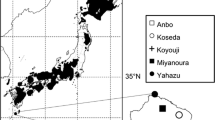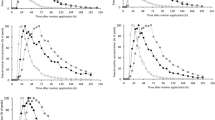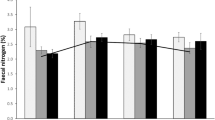Abstract
Three tame, hand-reared adult roe deer (Capreolus capreolus) were fed a low-quality diet (blueberry stems) or high-quality concentrate either restricted or ad libitum in summer and winter. Total mean retention time (TMRT) and rumen retention time (RRT) were significantly longer, indigestible fill was significantly higher and apparent digestibility and intake were significantly lower when fed blueberry stems compared to concentrate. The feeding regimes of concentrate did not affect the digesta kinetic estimates, except that total fill and apprent digestibility were significantly higher when deer were fed ad libitum than when they were fed a restricted ration. TMRT was significantly longer when they were fed a restricted ration of blueberry stems than for ad libitum intake, whereas all other estimates were equal. Intake was significantly higher and TMRT and RRT were significantly shorter in summer compared to winter when they were fed concentrate. These findings support the theory that roe deer, as small-bodied concentrate selectors, are adapted to high intake, rapid turnover, and rapid digestion when fed high-quality concentrate. When fed a low-quality diet the roe deer may be limited by rumen bulk. A strategy based on increased rumen retention accompanied by increased cell-wall digestion has therefore severe limitations in roe deer. This indicates that roe deer are dependent on a selective feeding strategy to enhance winter survival.
Similar content being viewed by others
References
Baker DL, Hobbs NT (1987) Strategies of digestion: digestive efficiency and retention time of forage diets in montane ungulates. Can J Zool 65: 1978–1984
Cederlund G, Ljungquist H, Markgren G, Stalfelt F (1980) Foods of moose and roe deer at Grimsø in central Sweden; results of rumen content analyses. Swed Wildl Res 11: 169–247
Drozdz A (1979) seasonal intake and digestibility of natural foods by roe-deer. Acta Theriol 24:137–170
Fllis WC, Matis JH, Lascano C (1979) Quantitating ruminal turnover. Fed Proc 38:2702–2706
Ellis WC, Matis JH, Pond KR, Lascano CE, Telford JP (1984) Dietary influences on flow rate and digestive capacity. In: Gilchrist FMC, Mackie PI (eds) Herbivore nutrition in the subtropics and the tropics: proceedings of a conference on herbivore nutrition in the subtropics and tropics, 5–9 April 1983, Pretoria, South Africa. The Science Press, Craighall, pp 269–293
Faichney GJ, Boston RC (1983) Interpretation of the faecal excretion patterns of solute and particulate markers introduced into the rumen of sheep. J Agric Sci 101:575–581
Grovum WL, Williams AJ (1973) Rate of passage of digesta in sheep 5. Theoretical considerations based on a physical model and computer simulations Br J Nutr 30:377–390
Hanley TA (1982) The nutritional basis for food selection by ungulates. J Range Manage 35:146–151
Hofmann RR (1989) Evolutionary steps of ecophysiological adaptation and diversification of ruminants: a comparative view of their digestive system. Oecologia 78:443–457
Holand Ø (1992) Winter digestive strategy of a concentrate selector in Norway: the European roe deer. Can J Zool 70:1331–1335
Holand Ø, Staaland H (1992) Nutritional stategies and winter survival of European roe deer in Norway. In: Brown E (ed) Biology of deer. Springer, New York Berlin Heidelberg, pp 423–428
Holleman DF, White RG (1989) Determination of digesta fill and passage rate from nonabsorbed particulate phase markers using the single dose method. Can J Zool 67:488–494
Illius IJ, Gordon AW (1992) Modelling the nutritional ecology of ungulate herbivores: evolution of body size and competitive interactions. Oecologia 89:428–434
Klein DR (1985) Population ecology: the interaction between deer and their food supply. In: Fennesy PE, Drew KR (eds) Biology of deer production: proccedings of a conference on the biology of deer production, 13–18 February 1983, Dunedin, New Zealand (Bulletin 22). Soc NZ. Wellington, pp 13–22
Laca EA, Demment MW (1991) Herbivory: the dilemma of foraging in a spatially heterogenous food environment. In: Palo RT, Robbins CT (eds) Plant defenses against mammalian herbivory. CRC Press, Boca Raton, pp 29–44
Lallés JP, Delval E, Poncet C (1991) Mean retention time of dietary residues within the gastrointestinal tract of the young ruminant: a comparison of non-compartmental (algebraic) and compartmental (modelling) estimation methods. Anim Feed Sci Technol 35:139–159
Langer P (1984) Anatomical and nutritional adaptation in wild herbivores. In: Gilchrist FMC, Mackie PI (eds) Herbivore nutrition in the subtropics and tropics: proceedings of a conference on herbivore nutrition in the subtropics and tropics, 5–9 April 1983. Pretoria, South Africa, The Science Press, Craighall, pp 185–203
Lundberg P, Palo RT (1993) Resource use, plant defenses, and optimal digestion in ruminants. Oikos 68:224–228
Mautz WW, Petrides GA (1971) Food passage rate in white-tailed deer. J Wildl Manage 35:723–728
Milchunas DG, Dyer MI, Wallmo OC, Johnson DE (1978) In vivo/in vitro relationships of Colorado mule deer forages. Colo Div Wildl Spec Rep 43:1–44
Penry D, Jumars P (1987) Modelling animal guts as chemical reactors. Am Nat 129:69–96
Renecker LA, Hudson RJ (1990) Digestive kinetics of moose (Alces alces), wapiti (Cervus elaphus) and cattle. Anim Prod 50:51–61
Ryg M, Jacobsen E (1982) Seasonal changes in growth rate, feed intake, growth hormone, and thyroid hormones in young male reindeer (Rangifer tarandus tarandus) Can J Zool 60:15–23
Shipley RA, Clark RE (1972) Tracer methods for in vivo studies. Academic Press, New York
Spalinger DE, Robbins CT, Hanley TA (1986) The assessment of handling time in ruminants: the effect of plant chemical and physical structure on rate of breakdown of plant particles in the rumen of mule deer and elk. Can J Zool 64:312–321
Sibly RM (1981) Strategies of digestion and defection. In: Townsend CR, Callow P (eds) Physiological ecology: an evolutionary approach to resource use. Sinauer Associates, Sunderland, pp 109–142
Spalinger DE, Robbins CT, Hanley TA (1993) Adaptive rumen function in elk (Cervus elaphus nelsoni) and mule deer (Odocoileus hemionus hemionus) Can J Zool 71:601–610
Staaland H, White RG (1991) Influence of foraging ecology on alimentary tract size and function of Svalbard reindeer. Can J Zool 69:1326–1334
Suttie JM, Simpson AM (1985) Photoperiodic control of appetite, growth, antlers and endocrine status of the red deer. In: Fennesy PE, Drew KR (eds) Biology of deer production: proceedings of a conference on the biology of deer production, 13–18 February 1983, Dunedin, New Zealand (Bulletin 22). Soc NZ, Wellington, pp 429–432
Van Soest PJ (1982) Nutritional ecology of ruminants. O and B Books, Corvallis
Van Soest PJ, Wine RH (1967) Use of detergents in the analysis of fibrous feed. IV. Determination of plant cell wall constituents. J Assoc Off Anal Chem 50:50–55
Weston RH (1984) Rumen digesta load in relation to voluntary feed consumption and rumination in roughage-fed young sheep. Can J Anim Sci [Suppl] 64:324–325
White RG, Holleman DF, Hubbert ME, Staanland H (1987) Herbivores in cold climates. In: Hecker JB, Ternouth JH (eds) The nutrition of herbivores: second international symposium on the nutrition of herbivores. Academic Press, Sydney pp 465–486
Wood AJ, Cowan I McT, Nordan HC (1962) Productivity of growth in ungulates as shown by deer of the genus Odocoileus. Can J Zool 40:593–603
Zar JH (1974) Biostatistical analysis, 2nd edn. Prentice-Hall, London
Author information
Authors and Affiliations
Rights and permissions
About this article
Cite this article
Holand, Ø. Seasonal dynamics of digestion in relation to diet quality and intake in European roe deer (Capreolus capreolus). Oecologia 98, 274–279 (1994). https://doi.org/10.1007/BF00324215
Received:
Accepted:
Issue Date:
DOI: https://doi.org/10.1007/BF00324215




